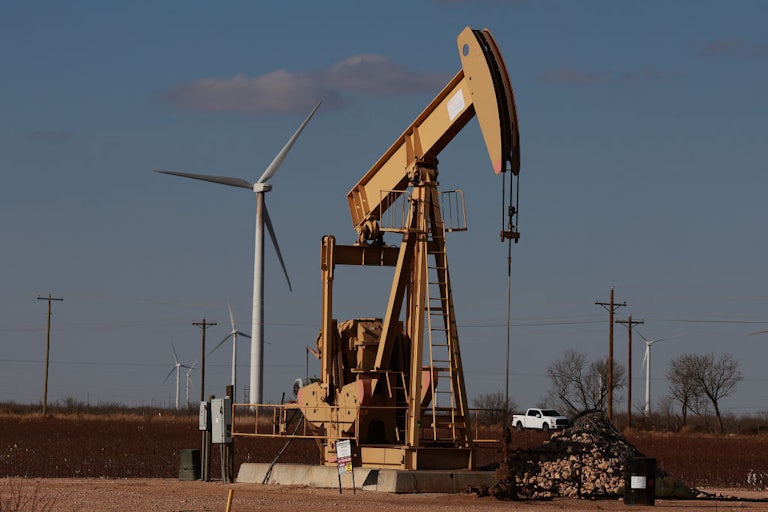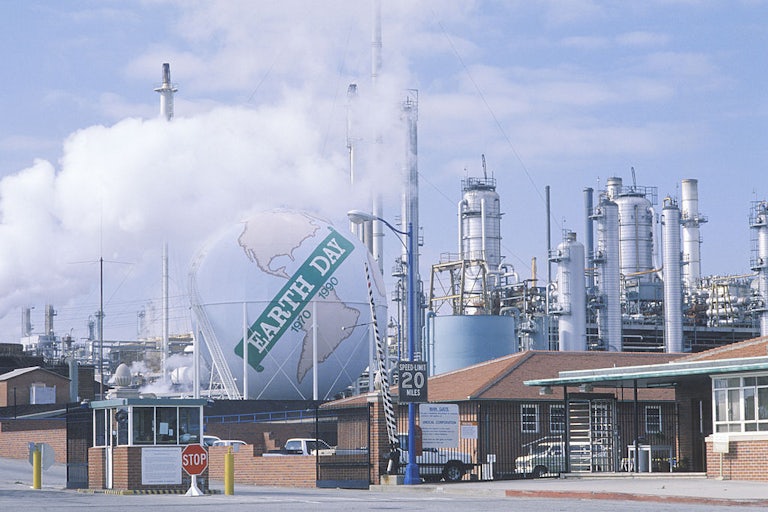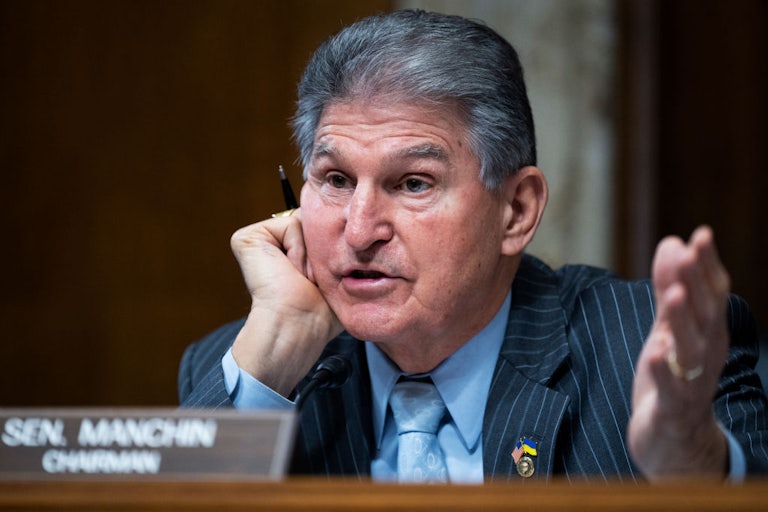The Real Reason Americans Are Addicted to Lawns
“People don’t like lawns. That’s the irony.”

What’s the best way to make your yard more environmentally friendly? Articles on the topic abound this time of year. We’re now halfway through “No Mow May,” an interesting initiative that began in the U.K. and is spreading in the United States. Abstaining from lawn maintenance for a month to help bee populations is certainly easier than ripping up your lawn and planting native wildflowers—which can be pretty expensive and time-consuming. But No Mow May doesn’t solve the broader issues of water use, pesticides, and fertilizer runoff. And it might even be counterproductive.
To help me make sense of all of this, I called up Paul Robbins, dean of the Nelson Institute for Environmental Studies at the University of Wisconsin-Madison, who literally wrote the book on lawn culture. His advice wasn’t what you typically hear in these conversations. Instead of encouraging individuals to plant wildflowers to save the bees or guilting people for their front-yard greenery, he said, we might be better off chipping away at some of the industry issues that make lawns so pervasive in the first place.
This interview has been edited and condensed for length and clarity.
We’ve known for quite a while that lawns aren’t the most environmentally friendly option for a variety of reasons, but they remain the overwhelming norm in this country. What do you feel are the top factors in that?
There’s a really simple answer to this: Most of the houses that people live in have already been built. This is deeply structural: The actual housing stock, the lot size, the footprint of the house, the landscaping choices made by developers—which are all value-engineering choices—have all already been made. No one puts in a lawn; they buy a house and it has a lawn, which puts the burden on them to somehow get rid of it, which is actually an enormous undertaking. It takes more work than just leaving it where it is.
Having said that, people don’t like lawns. That’s the irony; more and more people don’t want them, but nothing has changed. The reason it hasn’t changed is that everything that has nothing to do with lawns would have to change first.
It sounds like you’re saying, at least in part, it’s an industry problem.
As in the housing industry, yes. I’m not even talking about the fact that there’s a $10 to $40 billion lawn industry that’s actually invested in keeping them. There’s a deep investment in maintaining your need for lawns and to off-load the pain that they are to you by providing services—massive amounts of service provision.
And they tell people that they have problems. Scotts won awards for telling people to ask for such and such a product: “You have a problem, go ask for that.” You would never have done that back when it was a mom and pop hardware store in the 1980s. If you had a problem with your lawn, you might go and ask somebody at Ace Hardware, but to go and say, “I need this chemical, this product”?
The press is constantly saying lawns are about “American culture—we have this weird anomalous culture, and aren’t Americans odd?” when in fact it’s all rather obvious: We’ve got a really weird housing market, once you get outside the urban core, and you’ve got an industry that needs to sell this stuff. And most people really don’t want to have them and would love to replace [them] with something else.
But presumably that’s incredibly labor intensive, because it’s much easier to pay someone to mow your lawn.
Yeah. Well, it’s possible people are more interested in DIY culture in general terms. You know, The New York Times is filled with stories about beekeeping. But how many people keep fricking bees? Not that many. So that’s great that some hipster in Brooklyn is keeping bees—I think that’s wonderful. But am I counting on hipsters in Brooklyn to save the planet? No. Nor am I counting on busy, middle-class people pulling up their lawns. It’s unfair to burden them with this problem because they can’t solve it. So: Could we come up with an industry that somehow can make margins by replacing your lawn with something that takes less struggle and supports pollinators? Yeah, I actually think we can.
Really?
Well, I don’t have much confidence in capitalism. But having said that, yeah, there’s enough people out there who are interested in alternatives that if you squeeze a little you can start getting some options. In Canada, when we started studying this stuff, bans were being placed on the sale of certain chemical products—pesticides in particular. That’s something you can put tighter controls on. Once you pull pesticides out, that opens out all kinds of alternatives to lawns, because you’ve got to have something, and you’ll pay for it. So there might be some regulatory action to open the opportunity for that.
So there are a couple ways bans and regulations are starting to enter the American system. One, with water use.
Yeah, water’s going to kill it west of the hundredth meridian. East of the Mississippi, it’s a little harder to imagine. We’ve got plenty of water here, and it’s only going to get wetter.
And then, two, with bans on gas-powered either leaf blowers or lawn mowers, which is starting to happen. To what extent do these things make a difference in terms of the viability of lawns, or are we going to need something much bigger?
Banning these engines is a good thing in and of itself for air quality, to say nothing of like, carbon. But it’s not going to make the lawn go away. Everything’s just going to be electric.
The pesticide market could be regulated better I think, by a long shot. I do see room for regulatory interventions here.
Well there might be political support for that, given the research about what pesticides are doing in terms of cancer risk.
Cancer risks, and God knows what they’re doing to reproductive health. I’m not a public health expert, but we’re all buying organic cause we’re so worried about all these chemicals in the system, and people are dumping this shit on their own lawns! And it tracks into the house—I’ve seen the organic chemistry—it’s all over. It tends to decay in sunlight, but once it’s in your house dust, your kids are eating it, curtains—man, it’s everywhere. It’s in your body. We’re covered in this stuff. See, homeowners, they have no margin, so homeowners will always use more pesticides than they need, cause they’re not a farmer. No farmer would ever use a drop more Roundup than they have to, whereas a homeowner will use about 50 times as much because the marginal cost is so small relative to their other expenses.
That could have some regulatory legs. I think people don’t want that.
So maybe going the human health route rather than the “save pollinators” route might be more effective?
Yes, and I say that as someone who runs an environmental studies program. Environmental justice comes first. Most of these things are totally unnecessary cosmetic pesticides, as opposed to growing food for millions of people.
So when you do see these lawn clashes come out—I’m thinking of a suit in Maryland involving a homeowner association—is it because people are worried about home value? Because as you say, people don’t love lawns so much, but there’s something going on here.
HOAs are fascist about everything. I mean, have you ever seen what a homeowners’ association code looks like? There are still racial covenants on some people’s property—they’re inactive because of the Fair Housing Act, so they’re trumped by federal law. But then why are they still on there? There’s a lot of reasons that HOAs operate the way they do, and they are about property values, without question—resale value. And of course it’s a kind of moral economy that comes with that that enforces all these things, and lawns are just one tiny piece of that.
It sounds like you’re saying that regulating input is going to be more effective than regulating behavior or giving people some kind of marginal incentive for planting native plants or something like that.
I’d like to think that positive incentives work, I’m willing to be proven wrong. I haven’t studied it, so I’m not here to say it’s a bad idea. But you’ve got to offset the cost, because coming up with alternatives is a pain; it’s really difficult.
In Madison we also have a law on the books—I call it a freedom-to-farm law because that’s the only correlate in the law books that I know, but it’s not a freedom to farm, it’s a freedom to let your lawn go to shit. It makes it harder for you to be sued by your neighbors if you choose alternatives like prairie grass. It’s not a law that tells you to do something or even pays you to do something; it just keeps you from being sued for doing something. Even that would be a good step from a regulatory point of view.
![]()
Good News
Rooftop solar, if installed aggressively, could potentially meet a third of the U.S. manufacturing sector’s power needs, according to a study from Northeastern University researchers.
![]()
Bad News
We’re now on track to hit the threshold of 1.5 degrees Celsius (2.7 degrees Fahrenheit) of warming by 2027, thanks to climate change and the added effects of El Niño.
Stat of the Week
.png)
That’s how much air pollution from oil and gas production costs in terms of health effects across the U.S., according to a new study. States with higher oil and gas production had correspondingly higher health costs.
Elsewhere in the Ecosystem
What the EPA Can’t Say About Its New Power Plant Rules
Last week, the Environmental Protection Agency proposed regulations to cut almost all the emissions from the power sector by 2040—understandably making headlines. But as Emily Pontecorvo and Robinson Meyer point out at Heatmap, the EPA has to strike a delicate balance between climate goals and a Supreme Court ruling last year that said the agency has relatively limited authority to regulate greenhouse gas emissions from power plants and would have to restrict itself to things taking place “within the fenceline” of the plants themselves:
The EPA’s new proposal tries to hew within those guidelines. The agency has determined that the best available technology to reduce emissions directly from fossil-fuel-burning power plants is to install carbon-capture equipment. Carbon-capture-and-storage technology, or CCS, is now affordable and feasible, the agency asserts.
“There’s a 100% chance that this will be challenged in court,” Michael Gerrard, a Columbia Law professor and the director of the Sabin Center for Climate Change Law, told us. “The debate will largely be about if CCS is ‘adequately demonstrated.’”
At stake, too, is the question of whether the rules represent a Trojan horse—that although the proposal appears to comply with the Court’s guidelines, the expense and hassle of installing carbon-capture equipment is meant to force utilities to shift to renewables anyway. That could in fact be the rules’ practical effect. (Some environmentalists will admit—although not on the record—that they like the rules for this reason.)
Read Emily Pontecorvo’s and Robinson Meyer’s article at Heatmap.
This article first appeared in Apocalypse Soon, a weekly TNR newsletter authored by deputy editor Heather Souvaine Horn. Sign up here.

.png)




.png)

.png)

.png)

.png)

.png)